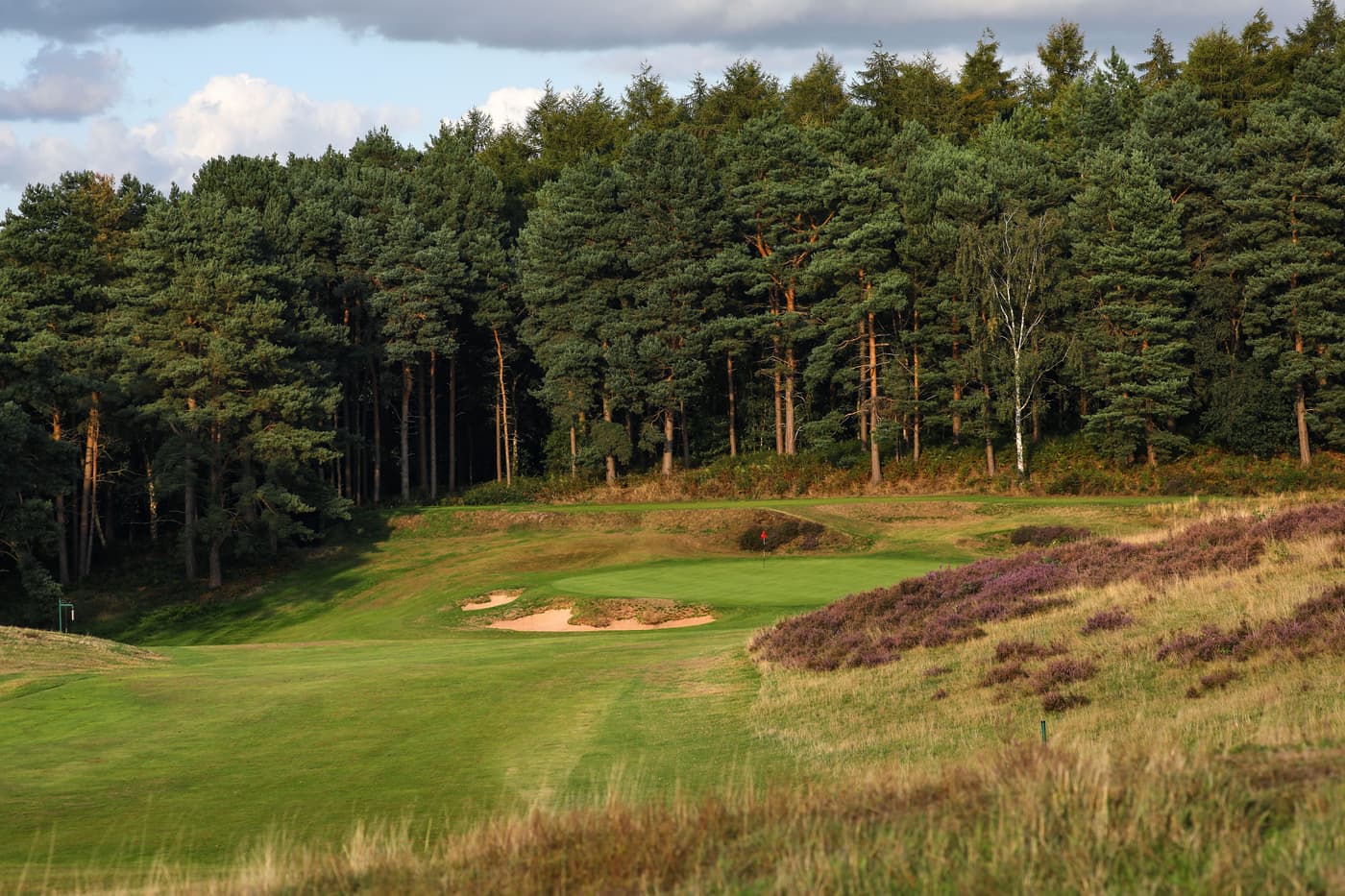
Delamere Forest
Cheshire, England
- AddressStation Rd, Delamere, Cheshire CW8 2JE, UK
The Delamere Forest Golf Club originated in 1910 when eleven local business men got together informally and agreed on forming a golf club in the ancient hunting grounds known as Delamere Forest. The land was underwater during prehistoric times, making for a sandy foundation that allows for year-round golfing. Even after a heavy downpour, the greens still play like they haven’t seen rain in weeks.
The renowned golf course architect Herbert Fowler designed the original course and today it still has a fine collection of challenging par fives, short and difficult par fours as well as some long and testing par threes. This ‘hidden gem’ is certain to test your game.


The shortest hole, the 6th, is arguably one of the most challenging. Accuracy is everything, should you find yourself either side of the green you face an arduous chip to get yourself back on track. It’s a hole that has been known to strike angst into even the most experienced golfer – Lord Hawke, captain back in the ‘50s even had an alternative tee constructed in the trees, now known as Hawke’s Folly.
Off-course facilities take place in a redesigned 'Cheshire Black and White' style building, originally designed by the founding member Alfred Powles. Powles was a prominent architect who took a fancy to the designs and architecture of the surrounding area. Facilities include a new visitor's locker room, member's lounge, improved formal dining room, refurbished member's locker rooms, casual lounge, and a new Professional's shop. Sitting in the casual lounge after a day of golf will offer fantastic views over the course and the stunning Cheshire countryside.
Only four golf professionals have been employed at Delamere Golf Club since its inauguration. The original golf pro, renowned James Arundel, had a strong Scottish golfing background and provided professional services for 35 years. The last golf pro to be hired, Martin Brown, has been a qualified PGA Professional since 1990. He is currently a Level 3 Coach and Class AAT PGA Member.
James kindly contributed the above article.
John Mulder, former Hon Secretary of Delamere Forest Golf Club, contributed the following article:
Despite the word 'Forest' in its title, Delamere is a natural heathland course. Certainly, trees are part of the strategy on several holes, but, in general, Delamere Forest provides a glorious backdrop to the panoramic views from the higher parts of the course.
Fowler had no qualms about asking the golfer to undertake a number of blind drives, carrying some considerable distances and enjoying the healthy exercise of hill climbing. Overall, there is much variety in hole lengths and every kind of shot will be called for, but the opening five holes really stretch the average player.
There are many holes with character, for example the 5th, with a long uphill carry to the green with a pond to the left and below the green and the need to hold the shot up to that side. The 6th is a short hole from an elevated tee to a small green set at an angle to the tee with enticing views over the pond below the green to the left, with woods and fields in all directions. The 8th requires a long straight tee shot to find a narrow fairway to give a long iron shot to a steeply sloping green. This hole was reached from the medal tee in the 1970s by one of our past members, Mr George Johnson. The 15th hole is a dogleg left with a blind drive over a hill and an out of bounds in the Forest on the left. The raised plateau green is situated in a delightful dell with a bell to be rung to tell those behind that the coast is clear, with the finishing hole having a rough patch of reeds just short of the green.
The course leaves and returns to the clubhouse twice and players cross at the 6th and 16th tees.
In 2018, the club celebrated the conclusion of a six-year programme to restore its historic heathland course back to the original 1910 design intent.
Under the guidance of architect Tom Mackenzie, every bunker was returned to its Herbert Fowler design and greens were enlarged to provide new pin placement options and run-off areas.
Officially opened in 1911 with a challenge match featuring James Braid, Ted Ray, Sandy Herd and James Arundel, the course was altered in 1959-60 by Hawtree Ltd. Work included bunker remodelling, fairway realignment at #3, #6, #11 and #17 and greens reshaping at #1, #2, #3 and #18. Fred W. also suggested a tree planting programme, which the club duly implemented.
Nearly sixty years later, the course was more than ready for this Tom Mackenzie upgrade. New millennium alterations also included the addition of eight new tees to challenge better players and the lengthening of the 18th hole.
Past Captain Steve Lamb commented: “It’s been a long process of change for the club, but the outcome has been well worth the wait and all of the members are proud to show visitors just how well the course plays and how good it looks.
Delamere Forest has always had a strong reputation as a quality course with great turf and superb greens. Now we believe that reputation will be enhanced with the changes that we’ve made under the direction of one of the world’s most respected course architects.”
Course Reviews
Leave a Review
This course has not been reviewed.
If you have played this course, consider .
Thanks for the review
Your review has been successfully submitted and will be reviewed for approval.
Course Reviewed
You’ve already submitted a review for this course.
Course Architect
View All
Herbert Fowler was introduced to golf at Royal North Devon when visiting nearby Bideford on banking business in 1879 and he became a club member, winning the Prince of Wales Medal two years later.



